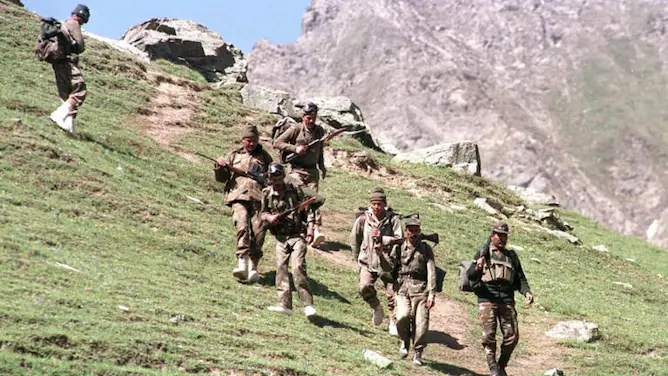
Miyan Saab Sent Me to Take the Blows” , The Quiet Diplomacy Behind Kargil’s Final Chapter
In the annals of military diplomacy, few moments are as poignant, ironic, and revealing as the July 11, 1999 DGMO-level meeting at Attari, a quiet yet decisive event that helped bring the Kargil War to a close. The meeting, marked by an unusual arrival and a memorable quote, exposed the desperation and isolation of Pakistan’s military leadership and underscored India’s firm resolve.
The Kargil Conflict: A Brief Recap
The Kargil War, fought between India and Pakistan from May to July 1999, was triggered when Pakistani soldiers and militants infiltrated Indian territory across the Line of Control (LoC) in the Kargil sector of Jammu and Kashmir. The intrusion caught India off guard, leading to Operation Vijay, a full-scale military response involving air strikes, artillery bombardments, and infantry assaults.
By early July, Indian forces had recaptured most of the strategic peaks. International pressure especially from the United States—mounted on Pakistan to withdraw. It was in this context that Prime Minister Atal Bihari Vajpayee made a decisive move.
The Phone Call That Changed Everything
On July 4, 1999, PM Vajpayee called his Pakistani counterpart, Nawaz Sharif, urging him to send his Director General of Military Operations (DGMO) for direct talks with the Indian DGMO. The goal was clear: to ensure a full and unconditional withdrawal of Pakistani forces beyond the LoC.
This diplomatic outreach was not just a gesture of peace, it was a strategic maneuver to avoid further escalation and to formalize Pakistan’s retreat through military-to-military communication.
The Meeting at Attari: A Surprising Sight
On July 11, India’s DGMO Lt Gen Nirmal Chander Vij (retd) and his deputy Brig Mohan Bhandari (retd) traveled to Attari near Amritsar for the meeting. What they saw on arrival was unexpected: Pakistan’s DGMO Lt Gen Tauqir Zia (retd) stood alone at the border, smoking, his cap askew.
Bhandari, who had met Zia during earlier Siachen talks, greeted him with surprise:
“Ye kya hai Tauqir… akele?” (How come you are alone?)
Zia’s reply would become legendary:
“Kya karun? Miyan Saab ne joote khane ke liye akele bhej diya.” (What could I have done? Miyan Saab sent me alone to take the blows.)
The phrase, laced with irony and resignation, revealed the internal dynamics of Pakistan’s leadership. ‘Miyan Saab’ was a reference to Nawaz Sharif, who had sent Zia alone to face the consequences of a failed military gamble.
Breaking Protocol, Setting the Tone
Military protocol typically requires such meetings to be attended by full delegations. The Indian side, taken aback, asked Zia to call in a few Pakistan Rangers from the nearby post for formality. Three officers joined him, but the Indian delegation deliberately made them wait for ten minutes, a symbolic gesture of displeasure over Pakistan’s betrayal during peace talks.
The meeting lasted three hours, during which India laid out clear conditions for Pakistan’s retreat:
- Full withdrawal beyond the LoC
- No laying of landmines
- No further skirmishes or attacks during the pullback
Zia and his officers took notes silently. When asked if they had any doubts, Zia simply said:
“No doubt.”
A Quiet Lunch, A Quieter Exit
After the meeting, the Indian side hosted a modest lunch for the Pakistani delegation. There were no speeches, no handshakes for the cameras, just a quiet acknowledgment of the moment. Zia and his officers left without fanfare, their mission complete, their defeat acknowledged.
But the story didn’t end there.
Violations and Retaliation
Despite agreeing to the conditions, Pakistani troops violated the terms. They laid landmines and launched attacks on Indian soldiers during their retreat. This breach of trust enraged Indian commanders.
From July 15 to 24, India responded with heavy shelling on Pakistani posts across the LoC. It was only after this sustained retaliation that Pakistan fully pulled back, and the conflict officially ended on July 25, 1999.
Had Pakistan adhered to the agreed conditions, the war could have ended by July 16 or 17, saving lives and reducing tensions.
Diplomacy Meets Military Resolve
The DGMO meeting at Attari was more than a tactical discussion, it was a symbolic turning point. It showed that diplomacy, when backed by military strength and international support, could resolve even the most volatile conflicts.
India’s insistence on a formal retreat, its refusal to cross the LoC, and its strategic restraint earned global praise. The meeting also exposed Pakistan’s internal disarray and lack of preparedness for the consequences of its actions.
Lessons from the Attari Meeting
- Military Diplomacy Matters: Direct communication between military leaders can de-escalate conflicts faster than political negotiations.
- Protocol Reflects Power: Zia’s solitary arrival was a visual metaphor for Pakistan’s isolation and defeat.
- Trust Is Fragile: Pakistan’s violation of retreat conditions showed how fragile ceasefire agreements can be.
- Symbolism Is Powerful: Zia’s quote became a lasting symbol of the war’s outcome and Pakistan’s miscalculation.
Legacy of the Kargil War
India celebrates Kargil Vijay Diwas every year on July 26 to honor the soldiers who fought and died in the conflict. The DGMO meeting, though less publicized, remains a critical chapter in that victory.
It reminds us that wars are not just won on the battlefield, they are also shaped by moments of diplomacy, courage, and clarity.
Final Thoughts
The phrase “Kya karun, Miyan Saab ne joote khane ke liye akele bhej diya” is more than a quote, it’s a window into the psyche of a defeated adversary. It captures the essence of a war that was fought with valor, ended with dignity, and remembered with pride.
As India continues to navigate complex geopolitical challenges, the lessons from Kargil and Attari remain as relevant as ever.
Stay updated with the latest news on Rapido Updates. Keep yourself updated with The World, India News, Entertainment, Market, Automobile, Gadgets, Sports, and many more